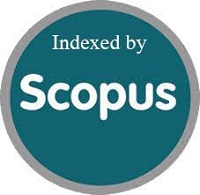Adaptasi dan Validasi Skala Iklim Organisasi Kreatif
DOI:
https://doi.org/10.15408/jp3i.v4i3.9297Keywords:
Validitas Konstruk, Iklim Organisasi Kreatif, Analisis Faktor KonfirmatorikAbstract
Abstract
Creative organizational climate is one element that has an important role in the learning organization. The purpose of this study was to examine the construct validity creative organizational climate that is modified from a scale Situational Outlook Questionnaire (SOQ) developed by Isaksen (2007). SOQ measure nine dimensions, namely the challenge / involvement, freedom, trust / openness, the idea of time, playfulness / humor, conflict, supported ideas, debate, and risk taking. This study used a total of 240 respondents.. The method of analysis used is confirmatory factor analysis (CFA) by using LISREL 8.70 software. The results of calculation can be concluded that all dimensions require modifications to obtain a fit model.
Abstrak
Iklim organisasi kreatif adalah satu elemen yang memiliki peran penting dalam organisasi belajar. Tujuan penelitian ini adalah untuk menguji validitas konstruk iklim kreatif yang dimodifikasi dari skala Situational Outlook Questionnaire (SOQ) yang dikembangkan oleh Isaksen (2007). SOQ mengukur sembilan dimensi, yaitu tantangan, kebebasan, kepercayaan/keterbukaan, gagasan tentang waktu, humor, konflik, gagasan yang didukung, debat, dan pengambilan resiko. Penelitian ini menggunakan 240 responden. Metode analisis yang digunakan adalah Analisis Faktor Konfirmatori dengan menggunakan perangkat lunak LISREL 8.70. hasil yang telah diukur dari penelitian ini LISREL 8.70. hasil dari penghitungan dapat disimpulkan bahwa semua dimensi membutuhkan modifikasi untuk mendapatkan model yang fit.
References
DAFTAR PUSTAKA
Crespeel, P., dan Hansen, E. (2008). Work climate, innovativeness, and firm performance in the United States forest sector: In search of a conceptual framework. Can.J.Res. Vol. 38:1703- 1715. DOI:10.1139/X08-027.
Dzulkifli, B.dan Noor, H. M. (2012). Assesing the organizational climate towards developing innovative work behavior: A literature review. 3rd International Conference on Business and Economic Research. ISBN: 978-967-5705-2.
Isaksen, S. G. (2007). The situational outlook questionnaire: Assesing the context for change. Psychological Reports. pp.455-466.
Isaksen, S. G., Lauer, K.J., Ekvall, G., dan Britz, A. (2001). Perceptions of the best and worst climates for creativity: Preliminary validation evidence for the situational outlook questionnaire. Creativity Research Journal, Vol.3, No.2, 171-184.
Isaksen, S. G., dan Ekvall, G. (2010). Managing for innovation: The two faces of tension in reative climates. Journal of Creativity and Innovation Management. Vol.9, No.2, pp.73-88.
Lamers, F. (2007). To be or not to be: Innovativeness by coherent climate for creativity and change? Bachelor Thesis Administration. Version:8.
Priester, R. (2009). Creative climate in the financial service industry. Creative studies graduate student masters projects. Paper 109.
Samad, S. (2006). The differential effects of creative organizational climate and organizational commitment on learning organization. Disertasi. Malaysia: Universiti Teknologi MARA.
Umar, J. (2012). Analisis faktor. Modul perkuliahan. Fakultas Psikologi. UIN Jakarta. Tidak dipublikasikan.



